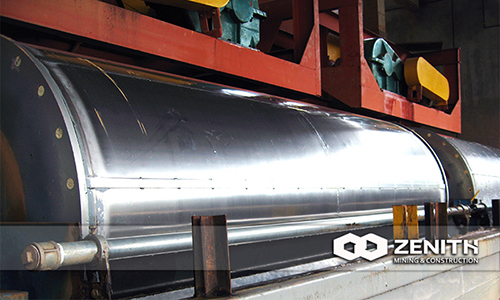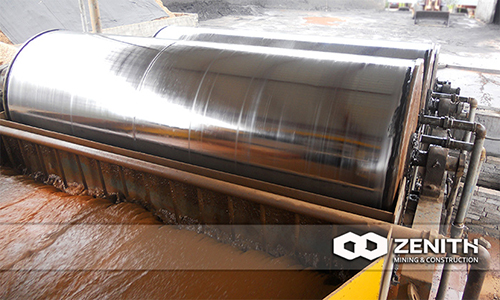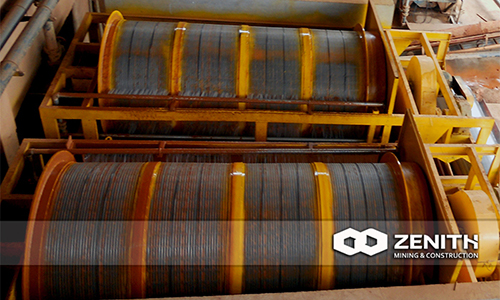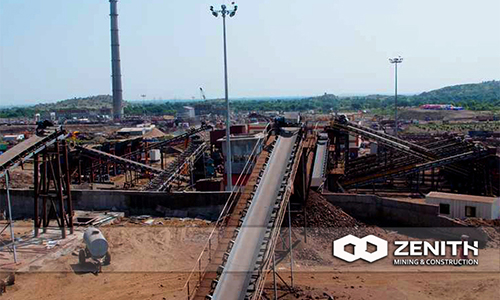In the development of human society, the invention of the steel plays a very big role. Even now, the production of steel is still a very important figure to measure one country's industrial development level. Before smelting the steel, the technology to improve the grade of Iron ore to match the steel industry's demand is becoming more and more important for every country. Zenith is with strong technical stength to be your support to do the Iron ore processing. Here is the brief introduction of iron ore pcorssing technology as below:

1. The brief introduction of Iron ore
Broadly speaking, all the stone which contains Fe elements can be named iron ore. From the narrow sense, only the raw ore which can reach the standard of industry requirements or can reach the standard after processing can be named Iron ore. The main type for steel smelting is Magnetite (Fe3O4), hematite(Fe2O3), siderite(FeCO3),etc. Fe is always exists in nature by the state of the compound and It occurs chiefly as the dioxide. Here is the specification of the above Iron ore.
| Name | Content | Specific gravity | Color | Theoretical grade | Cutoff grade | Production grade | Remark |
| Magnetite | Fe3O4 or FeO·Fe2O3 | 5.15 | Dark gray | 72.40% | TFe≥20%, mFe≥15% | TFe≥25%, mFe≥20% | |
| Hematite | Fe2O3 | 5.26 | Dark red | 70% | TFe≥25% | TFe≥28% | |
| Siderite | FeCO3 | 3.8 | Steel grey | 48% | TFe≥20% | TFe≥25% | |
| Limonite | Fe2O3·nH2O | 3.6~4.9 | Ocher or brown | 62.90% | TFe≥25% | TFe≥30% | |
| Note: If the Magnetie contain too much ironsilicate, ironsulphide and iron carbonate, please use the mFe standard. | |||||||
2. The processing technology for above iron ores:
Nearly for all the Iron ores, need crush and grind the mineral ore into the suitable size before the beneficiation processing. The crushing section and grinding section for all of them will be almost same. So we will pay more attention on introduce the beneficiation processing technology.
Magnetite: a. Low intensity magnetic separation (LIMS) technology.
b Low intensity magnetic separation technology+ flotation process
Hematite: a. High intensity magnetic separation technology;
b. Reduction roasting process+Low intensity magnetic separation technology
c. High intensity magnetic separation technology+gravity treatment process+flotation techniques
Siderite: a. High intensity magnetic separation technology
b. Neutral roasting process+low intensity magnetic separation technology
c. Flotation process or Flotation + high intensity magnetic separation technology
Limonite: a. High intensity magnetic separation techniques
b. Roast reduction process+ Low intensity magnetic separation techniques
c. High intensity magnetic separation techniques+ flotation techniques
3. How to setup the Iron ore processing plant?
Frist, doing the geological prospecting to know the
deposit, position and the trend of your mine and make
sure it is with the the feasibility of developing or not.
Second, doing the dressing test is for choosing the suitable and economical mineral processing technology and recovering the Cu element inside the raw ore after detailed experimental study. The research report will be as the basis of the project feasibility study.
a. Spectral analysis & elements chemical analysis to fix the chemical composition of Iron ore
| Elements | Tfe | SiO2 | TiO2 | Al2O3 | Fe2O3 | FeO | MgO |
| Cotent % | 34.48 | 43.63 | 0.02 | 1.04 | 29.14 | 18.39 | 2.17 |
| b. Iron ore phase analysis to fix the type of your Iron ore ( magnetite, hematite, siderite, limonite or other type) | |||||||
| Item | TFe | mFe | Ferrosilite | Ironcarbonate | martite | hematite & limonite | Magnetic iron share |
| Content % | 35.15 | 29.76 | 3.22 | 1.56 | 0.33 | 0.28 | 84.67 |
From the above table, the content of mFe is 84.67 of the total Fe. It tell us the magnetite is oxygenated.
c. The texture and structure and mineral composition of the ore; To know the valuable mineral of your Iron ore like the magnetite, marite and the gangue which is associated with the Iron ore like, quartz, calcite, siderite, hornblende, actinolite, grunerite, etc.
| Item | Essential mineral | Auxiliary minerals | Tiny traces of minerals |
| Valuable mineral | Magnetite | martite | hematite, limonite |
| Gangue mineral | Quartz | calcite, siderite, hornblende | actinolite, grunerite |
d. The major metal mineral's embedded features; The Major element mineral's granulometric composition and distribution characteristics;
| Partical size (μm) | 2000-1168 | 1168-833 | 833-589 | 589-417 | 417-295 | 295-208 | 208-147 |
| Iron Ore | 0.18 | 0.34 | 0.55 | 0.56 | 1.16 | 3.75 | 6.16 |
| Gangue | 1.51 | 2.4 | 5.07 | 5.88 | 7.41 | 8.97 | 8.42 |
| Partical size (μm) | 147-104 | 104-74 | 74-43 | 43-35 | 35-15 | 15-10 | 10-0 |
| Iron Ore | 10.85 | 12.87 | 18.41 | 10.2 | 26.64 | 7.52 | 0.26 |
| Gangue | 8.82 | 8.4 | 12.79 | 6.36 | 18.66 | 5.06 | 0.25 |
| Particle mean size | Iron Ore | Gangue | |||||
| Content % | 38.54 | 51.68 | |||||
From the above table, the particle mean size of Iron ore is 40.06 μm and the particle mean size of gangue is 51.68 μm. Between the partile size of Iron ore -417 μm is around 97.82% It is easy to get rid of the gangue.
e. The different grinding size under low intensity magnetic separation (LIMS) - high intensity magnetic separation (HIMS) test for fixing the suitable grinding size.
| -74μm Passing Rate % | Products | Yeild Rate % | Grade % | Recovery Rate % | Remark | ||
| 44.8 | LIMS Concentration Ore | 20.7 | 55.5 | 40.57 | |||
| HIMS Concentration Ore | 40.72 | 36.4 | 52.33 | ||||
| Tailings | 38.58 | 5.2 | 2.01 | ||||
| Raw Ore | 100 | 28.32 | 100 | ||||
| 53.3 | LIMS Concentration Ore | 19.66 | 57.5 | 39.82 | |||
| HIMS Concentration Ore | 39.38 | 38.1 | 52.82 | ||||
| Tailings | 40.96 | 5.1 | 7.36 | ||||
| Raw Ore | 100 | 28.4 | 100 | ||||
| 63.8 | LIMS Concentration Ore | 19.51 | 58.9 | 40.6 | |||
| HIMS Concentration Ore | 38.94 | 38.75 | 53.32 | ||||
| Tailings | 41.55 | 4.15 | 6.08 | ||||
| Raw Ore | 100 | 28.3 | 100 | ||||
| 82.9 | LIMS Concentration Ore | 17.39 | 62.82 | 38.59 | |||
| HIMS Concentration Ore | 36.5 | 42.08 | 54.28 | ||||
| Tailings | 46.11 | 4.38 | 7.13 | ||||
| Raw Ore | 100 | 28.3 | 100 | ||||
| 90.7 | LIMS Concentration Ore | 17.1 | 64.95 | 39.12 | |||
| HIMS Concentration Ore | 33.77 | 45.3 | 53.87 | ||||
| Tailings | 49.13 | 4.05 | 7.01 | ||||
| Raw Ore | 100 | 28.4 | 100 | ||||
According the customer's target grade of final Iron ore can chose the suitable grinding size. Fox examble, the customer want to get the magnetite ore with grade 57.5% and the hematite with grade of 38.1% and the total recovery rate reach 90%. It can just use one stage ball mill grinding for saving the cost.

f.Exploratory Test; Make exploratory Test for the ore and make foreshadowing for condition test; If your Iron ire is rich in the Ti2O3, Cu, S, we can give you the advice to expand the production in the future.
g. Condition test; Base on the research, we will doing the condition test include grinding solution; grinding fineness; magnetic separation and flotation concentration solution; collector type and dosage; depressant type and dosage; activator type and dosage; modifier type and dosage; PH value; flotation time; pulp density, etc for fixing the technological parameter of beneficiation flowsheet;
h. Completely open closed-circuit test: Base on the above test, choose the beneficiation technology process and the process parameters. The test index should be with repeatability, stability and facticity.
i. Product check: Make multi-element analysis for the concentrate and tailing; Make sedimentation performance test for the concentrate and tailing.
j. Designing the beneficiation flow-sheet:Base on the above test, designing the most suitable beneficiation flow-sheet,technological parameter and reagent system.
k. Issuing Report Issuing report base on the above tests.
Third, choosing the suitable equipments base on the above test result.
Forth, build the foundation and doing the installation with our engineer. After receiving the deposit, we will send the technical drawing to you and send our engineer to supervise the foundation building and guide your staff to do the installation, then have a commissioning running. Meanwhile, they can train your staff at your site also.

4. Here is one project of Magnetite ore processing plant for your reference. Please see the flow chart of crushing section and the grinding and beneficiation sections.
a. In the crushing section, we use our PE900x1200 jaw crusher to crush the Iron ore from 800 to 220 mm and then use the s series cone crusher to crush the Iron ore into size 0-10mm. We use the belt conveyor for final output Iron ore with magnetic pulley to pre-taking out a part of waste rock before feeding ore into ball mill. It can imprpove the magntite ore with grade 3-6% higher and reducing the ore feeding of ball mill.
b. The crushed ore with size 0-10 mm will be fed into the wet grid type ball mill to grind it. And slurry will be classified by the spiral classifer. The particle with size above 0.52 mm will be returned to the ball mill to grind it again.
c. The particle with size minus 0.52 mm will be sent to the wet type low intensity magnetic separator (LIMS) ZCT-B1200x3000 to do the roughing first. The rough concentration ore will be sent to the tank, then it will be sent to the high frequency ming screen ZD5FG1216 to classify. The taillings will be sent to the tailing pool to wait for the concentrate processing by the inclined plate thickner.
d. The rough concentration ore will be sent to the high frequency ming screen to classify. The particle with size above 0.21 mm will be processed by the LIMS ZCT1200x3000 to do the dewatering magnetic separation. The concentration ore will be sent to the wet overflow type ball mill to grind it. The tailing will be sent to the tailling pool.
e. The particle with size minus 0.21 mm will be sent to the LIMS separator ZCT-B 1200x3000 and ZCT-B1050 to do the two stage cleaning. The tailing we will send to the tailing pool. The final concentration ore will be sent to the permanent magnet filter ZGYW-16 to do the dewatering. The dry concentration ore will be the final products.
"f.All the tailings in the tailing pool will be sent to the tailings recycling machine ZTLWK-8008 to do the scavenging. The concentration ore from it will be sent to the rough cocentration tank wait for cleaning process.
"
g. All the tailings will be dewatered by the inclined plate thickner ZNXB600/55. The tailings after dewatering will be with the water content around 24%. The tailings slurry will be transported to the tailing lake by slurry pump.
h. The above design is the complete plant for magnetite ore processing plant. The customer can get the magnetite powde as the final product. Some customer will choose the pelletizer to make iron ore ball or block and then doing the sintering process.
From the above project case, like the prticle size, water consumption, the pulp density and the processing capacity of each equipments and the magnetic intensity should be fixed after doing the above dressing test. If it is without the dressing test, nobody can ensure the whole plant's performance. That's why we always advise our customer to do the dressing test and get the dressing test report, then we can give you the quotation list with full deails. After many years, Zenith have full experiences to work together with the famous labratory in China to supply the full solutation to our distinguished customer. We do beleive that we will enjoy your trust by our professional and quality control.
5. Appendix I: The flow chart for the magnetite processing plant ( Crushing Section )
